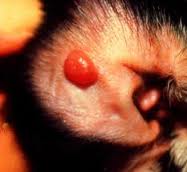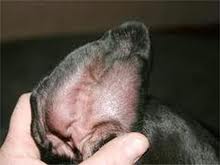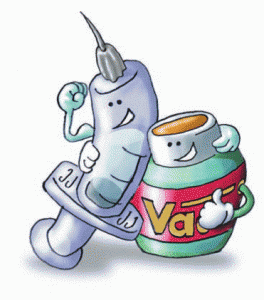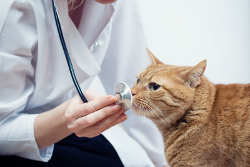A cat’s ear flaps are an extremely sensitive part of her anatomy. They protect the inside of her ears but are also very vulnerable themselves. Since they are so vulnerable yet important, it’s vial to know when something is wrong and how to correct it. The technical name for a cat’s ear flaps is “pinnae”.
Cats have the same hearing range as humans but have better hearing at higher frequencies. To put it in perspective: A human’s voice is at around 3000 Hz. A cat is capable of hearings sounds that are around 8000 Hz.
Most Common Ear Flap Problems
 Scratches and bites: Since the ear flap is so fragile it is very easy for them to become injured. Cats are notorious for biting and scratching each other during play and for all other reasons! This is one way for the ear flaps to get an infection. Cats also scratch themselves a lot and when they scratch their ears, they may make small lacerations that will leave them prone to infection. With a cat’s claws not being sanitary, when she touches or creates an open wound the bacteria gets inside and is able to multiply when the skin heals over it.
Scratches and bites: Since the ear flap is so fragile it is very easy for them to become injured. Cats are notorious for biting and scratching each other during play and for all other reasons! This is one way for the ear flaps to get an infection. Cats also scratch themselves a lot and when they scratch their ears, they may make small lacerations that will leave them prone to infection. With a cat’s claws not being sanitary, when she touches or creates an open wound the bacteria gets inside and is able to multiply when the skin heals over it.
- Ear Mites are a parasite that is very contagious among cats and other animals. This is the most common ear problem that cats have. Unfortunately, this is also very uncomfortable and stressful for your cat. Ear mites have a very characteristic look to them. There will be what looks like dry coffee grounds in your cat’s ears.
- Abscesses: Where the pinnae gets an infection it can start to swell and lead to abscesses. After a fight is usually when this will occur. An abscess is when an infected wound accumulates a lot of pus. A cat’s fur may help to hide abscess. So, a thorough investigation of the affected ear will be needed. It may be difficult to actually figure out what caused the abscess until the pus has been drained and cleaned. Since the ear flaps are so sensitive, abscesses can be very painful for your cat and can also have some serious side effects. If you notice an abscess, alert you veterinarian.
Symptoms of Ear Flap Problems
 Loss of appetite
Loss of appetite- Not playing or being active
- Flinching or not wanting to be pet due to pain
- Fever or inflamed areas
- Strange odor
- Dark black or yellowish discharge
- Dark brown ear wax when cleaning the ears
- In the worst cases when there are multiple symptoms present you cat may even begin to limp.
Other Ear Flap Problems
Hematoma
A Hematoma is also possible in the ear flaps and is not as common as an abscess. A hematoma is a blood clot that forms under the skin. It can be caused by scratching, fleas and trauma such as violent shaking of the head. Ear mites as well as infections in the ear canal can also lead to a hematoma.
Treatment for Ear Flap Problems
 Abscess Treatment
Abscess Treatment
The first thing that will need to be done is clipping the hair around the infected area. The next step will be draining the abscess, this will usually happen on its own over time. If it isn’t draining by itself then you will need to put a hot, wet washcloth on the infected area in twenty minute intervals, three times a day until it starts to drain.
Once drained you will have to clean the area three times a day with hydrogen peroxide. Do not use any other antiseptics and be sure to only use 3 percent peroxide. You will also need to prevent a scab from forming for two to three days and if one does start to form you will need to pick it away so it may heal properly. After two days, if there is still a foul smell coming from the infected area or if the area is extremely large, then you will need to take you cat to your veterinarian immediately.
To treat a Hematoma
The infected area will have to be expressed so the blood may be drained properly to prevent a deformity and scarring when the clot deflates. Serum can re-accumulate even when the clot is removed with a needle and syringe. The best treatment for this is surgery so a piece of skin can be removed to provide continued drainage.
Stitches are then place through both sides of the ears to prevent a pocket from forming. There will also have to be special collars worn to keep the cat from scratching and ripping the sutures or re-infecting the area.
Prevention of Ear Flap Problems
The best prevention is to not leave your cat outside unsupervised. This is when they get into fights with other cats that can lead to these infections. Other cats may have diseases or other health issues that can be transmitted when in a fight due to the clawing and biting.
Frequently check your cat’s ears so you can spot anything early on. The easiest way to do this is during a petting session. If your cat flinches while she is being pet then you know you need to look further under her fur to see if anything is there. Also, clean any scratches and bite marks you do find. They will fuss and not be happy when you do this but they will thank you for it later.
Additionally, make cleaning your cat’s ears part of a routine. Clean them at least once every two weeks and more often if they have been prone to ear infections and other ear problems in the past. It is very easy for dirt and other debris to get in there. The cleaner her ears are, the happier she will be, and the happier you will be.
Thanks for visiting www.catdandruffclinic.com, if you liked this article please like us using the side bar. And for more reading check out the Top Cat skin disorders every pet owner should know about.



Comments are closed.